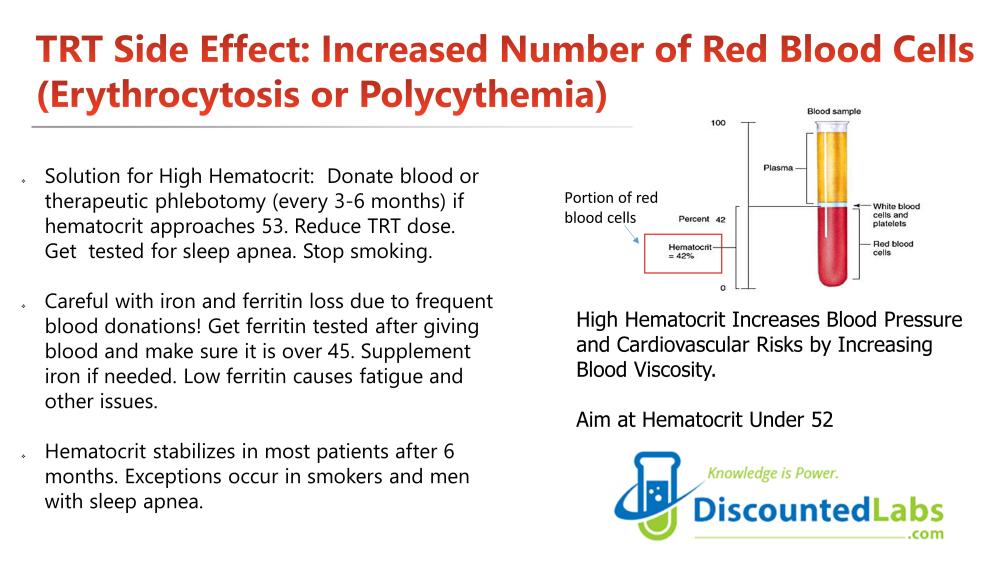How to Lower High Hematocrit - Effective Strategies

High hematocrit levels, which measure the percentage of red blood cells in the blood, can be signs of several underlying health conditions and they are also a common side effect of testosterone replacement therapy (TRT). High hematocrit levels can increase the risk of developing blood clots, strokes, and other serious complications, especially for those with an underlying condition. Low red blood cell levels, also known as low hematocrit levels, can indicate conditions such as anemia, while high red blood cell levels often signal dehydration and could indicate other conditions, such as polycythemia, increasing a person’s chance of developing blood clots or experiencing blood loss. We will review the different ways to lower the hematocrit and the number of red blood cells on TRT.
How to Lower the High Hematocrit Caused by Testosterone Replacement Therapy (TRT)
Testosterone replacement therapy (TRT) is one of the most effective ways to combat low testosterone levels, but it's vital that you understand the risks associated with the treatment. As with any form of hormone replacement therapy, there are a few downsides to receiving regular injections of testosterone. One of the main TRT side effects is increased hematocrit, also known as erythrocytosis, which can be a sign of androgen deficiency. This article will explain why this happens, the potential long-term health consequences, and how to prevent or manage this issue.
Since abnormally high hematocrit values can pose serious health problems, this article will analyze the correlation between testosterone therapy and high hematocrit. TRT, sleep apnea, smoking, and red blood cell production are contributing factors that can cause high hematocrit that can increase cardiovascular risks if not properly managed. This article explains the basics of how to manage high hematocrit while using testosterone therapy.
What is hematocrit?
There are several standard ways to measure red blood cells: hematocrit, hemoglobin, and RBC (red blood cell count). All of these are related, and doctors will usually look at two or more. Hematocrit, also referred to as the proportion of red blood cells, is a measurement of how much of a person's blood is made up of red blood cells, also known as whole blood. Hemoglobin, on the other hand, is a density or concentration measurement and is expressed in grams per liter or deciliter. (Hemoglobin is, if you will recall from your high school biology, the iron-based protein that transports oxygen.) RBC is a simple count and is usually expressed as the number of million red blood cells that you have per microliter. Usually, hematocrit is three times the amount of hemoglobin and can be measured through a simple blood sample test.

What are the normal ranges for hematocrit?
Normal levels of hematocrit for men range from 41% to 50%. normal level for women is 36% to 48%.
Why does TRT increase hematocrit?
Erythrocytosis is a medical condition that appears when the body makes too many red blood cells. RBCs are responsible for transporting oxygen to organs and tissues. When there are too many, the blood can become too thick and cause cardiovascular complications.
There are two types of erythrocytosis: primary and secondary. Problems with the bone marrow, such as bone marrow disease, are typically the cause of primary erythrocytosis. RBCs are made in the bone marrow, and something might trigger an increase in their production. Certain diseases or medications, such as testosterone replacement therapy, can cause secondary erythrocytosis.
Some studies concluded that testosterone reduces hepcidin (a hepatic hormone), which is related to iron absorption pathways. When hepcidin is reduced, erythrocytosis is increased [1]
An increase in hemoglobin (Hb) and hematocrit (Hct) is indicative of this medical condition. When the Hb is higher than 18.5 g/dL and the Hct is higher than 52% in men, the patient suffers from erythrocytosis.
What are the risks of high hematocrit?
One of the primary risks of testosterone that you need to be aware of is called polycythemia or erythrocytosis. This is a condition where your body produces too many red blood cells, also known as high hematocrit levels or secondary polycythemia. Hematocrit refers to the percent of red blood cell content in your blood, also known as Hct levels. If your hemocrit levels rise, your blood will become too thick or viscous. This can, in turn, make it more likely that you will develop strokes, heart attacks, and clotting events. Polycythemia is serious and potentially life-threatening if untreated.
Since the RBC count is too high in people with erythrocytosis, the blood viscosity also increases, which can lead to various potentially life-threatening medical issues such as venous thromboembolism. This essentially means that tiny blood clots separate from their original source and travel through veins and capillaries, causing blockages that result in stroke, myocardial infarction, or other complications related to reduced blood flow and blood volume. Individuals with high hematocrit levels may also be at risk for conditions such as polycythemia vera, a bone marrow disease that causes an abnormal increase in red blood cells and can lead to symptoms of polycythemia vera such as headache, dizziness, and fatigue. Other potential risks include congenital heart disease, exposure to high altitudes, and reactions to blood transfusions.
It can be quite stressful for a man who has finally gotten on TRT, feels better, and then finds out that his hemoglobin is high. Of course, he can always lower his testosterone dosage to try to solve the problem, but this may not be a solution that either doctor or patient wants to pursue. Many men have found that their erectile dysfunction is greatly helped and/or morning erections and libido have returned. The last thing they want to do is lower their dose.
So why even worry about a high hemoglobin or RBC count? What’s a few extra red blood cells anyway?
Unfortunately, high hemoglobin (or RBCs) is a risk factor for ischemic stroke, i.e., the standard kind of stroke where there is a loss of blood supply to tissues such that permanent damage is usually incurred. [2] Of course, a stroke can be a life-changing (or life-ending) event and should be avoided at all costs. There is also a longer-term risk: elevated hemoglobin could lead to unhealthy iron store levels, which are associated with heart disease and dementia. Iron in tissues can lead to oxidative damage.
Just look at what some recent studies have concluded:
“Low and high hemoglobin concentrations in older persons are associated with a lower level of cognitive function in old age, particularly in semantic memory and perceptual speed.” [3]
“In older persons without dementia, both lower and higher hemoglobin levels are associated with an increased hazard for developing AD [Alzheimer’s Disease] and more rapid cognitive decline.” [4]
Can hematocrit stabilize in men on TRT?
Hematocrit may stabilize after long-term testosterone replacement. Although there is only one study done in mice, it may explain why hematocrit may eventually decrease and stabilize in men on TRT. There seems to be an adaptive mechanism that makes red blood cell indices change while hematocrit stabilizes. In some men, red blood cell indices (MCV and MCHC) start changing after starting TRT as a way for the body to compensate for the extra production of red blood cells. There are three red blood cell indices: mean corpuscular volume (MCV), mean corpuscular hemoglobin (MCH), and mean corpuscular hemoglobin concentration (MCHC). They are measured by a machine, and their values come from other measurements on a CBC panel. The MCV shows the size of the red blood cells. The MCH value is the amount of hemoglobin in an average red blood cell. The MCHC measures the concentration of hemoglobin in an average red blood cell. [5]
Another study that followed frequent blood donors found a reduction in ferritin in them, created as a way for the body to increase iron absorption in the presence of lower hematocrit. Ferritin and hematocrit stabilized after five donations.[6]
How to Lower High Hematocrit on TRT
Some physicians and TRT guidelines believe that the best way to lower hematocrit is to stop TRT. But stopping TRT can have negative consequences in the quality of life, as men who do so tend to stay hypogonadal for months, and most do not return to “normal levels.”. Fortunately, there are several ways to decrease high hematocrit and also potentially prevent it from happening.
Give Blood. This is a time-proven technique for men on testosterone therapy to lower their hemoglobin levels. And you are helping out someone else while you’re doing it! Every unit of blood donated can decrease hematocrit by 3 points, which is equivalent to one pint of blood. However, be careful not to donate more frequently than every 2.5 months, as the Red Cross advises, to prevent losing too much iron and ferritin, which can cause fatigue in men using testosterone therapy. You can check your iron and ferritin levels with this iron blood test. It's recommended that you donate when you are in the 51–52 hematocrit range. However, some organizations (like the Red Cross) will reject blood with a hematocrit higher than 53%, so it is good to avoid that high hematocrit level if you want to donate blood. Men who are rejected from blood donations because of high hematocrit can still give blood if their physicians call in an order for a therapeutic phlebotomy at the local blood center.
Lower Your TRT Dose. If you have high hemoglobin or hematocrit from testosterone therapy, then your doctor may require you to lower your dose. This is not always a bad thing, as some men are actually taking more testosterone than they actually need, which can lead to side effects in both the long and short term.
Drink Water. It is important to remember that hemoglobin is very dependent on your hydration levels. If you were dehydrated when you had your blood drawn, this could have made things worse. If you think you were dehydrated, discuss a retest with your doctor.
Treat Thyroid Issues. Hypothyroidism (low thyroid function) can lower your RBC counts, and hyperthyroidism (high thyroid function) can raise them, too. If you haven’t checked your thyroid function lately, this might be wise. And don’t forget to get a full thyroid panel, including thyroid antibodies, if you can afford it. [10]
Consider transdermal (topical) or oral testosterone. One research summary stated that topical testosterone creams or gels increase hematocrit, in general, less than intramuscular testosterone injections: “Intramuscular testosterone is the only form that significantly increases hematocrit above normal levels. However, it does so strongly, with up to a 6% change from baseline. The runner-up is testosterone gel, with an average increase of 2.5% over baseline levels.” [7]. Therefore, if you are on intramuscular injections and struggling with high hematocrit or hemoglobin, going on topicals may help a little. Discuss with your physician. NOTE: A cheap alternative is Compounded Testosterone Creams and Gels. Another emerging option is oral testosterone products.
Switch from intramuscular injections to lower-dose subcutaneous Subcutaneous Testosterone Injections. Two hundred thirty-two men took part in a University of California study. Baseline levels were recorded for all men in each of the four measurement areas and then again at 6–12 weeks post-treatment. The results showed that men who underwent subcutaneous testosterone (SubQ) injections had a 14% greater increase in total testosterone levels compared to the testosterone levels of intramuscular testosterone injection (IM) patients. SubQ patients also had a 41% lower hematocrit post-therapy than IM patients and 26.5% lower estradiol levels. For both groups of men, there were no elevated levels of PSA. [7]
Avoid or Reduce the Consumption of Red Meats. It is interesting because one of the criticisms that meat eaters level against vegetarians is that plant foods have many “anti-nutrients” that can slow down or bind with minerals such as iron. For example, organizations like Weston Price love to castigate vegetarians for their phytic acid consumption. Phytic acid is present in plant foods and binds to iron, magnesium, phosphorous, and calcium. It can, if overconsumed, lead to mineral deficiencies. However, Dr. Bernard points out that usually, it is likely very health-protective for most people because these minerals, as in the case of zinc and iron, are neurotoxic at even relatively low levels of tissue accumulation. Research has also shown that too much iron also contributes to heart disease, and there may be a link to colon cancer as well. [8]So, avoiding red meats, which are high in iron, stands a good chance of lowering your hemoglobin scores and protecting your long-term health unless some other preventative action is taken (such as giving blood). Actual dietary studies are required to support this statement. As a verification, one study of vegetarians and non-vegetarians found that females had significantly lower hemoglobin levels. Males had lower levels, but it may not have been statistically significant. [8] However, another study was more definitive and concluded: “It was found that hemoglobin, hematocrit, mean corpuscular hemoglobin, mean corpuscular hemoglobin concentration, white blood cells, neutrophils, serum ferritin, and serum vitamin B12 in vegetarians were significantly lower than control subjects.” [11] Ferritin is a key measure, by the way, because it indicates that tissue levels of iron are lower and thus will likely cause less permanent damage. (This study did show that some vegetarians were iron deficient, as should be noted.)
Fix Sleep Apnea. Sleep apnea can cause depleted oxygen saturation values that can enhance the body's ability to produce more red blood cells and hemoglobin as a way to compensate for the low blood levels of oxygen during the sleep cycle. And, sure enough, there are studies that confirm this as well. [12] So, if your hematocrit, hemoglobin, or RBCs are running high, think about getting tested for sleep apnea. A recent study commented that “one possible explanation is that repeated episodes of nocturnal hypoxia (low oxygen condition) lead to a hypercoagulable state that predisposes patients to thrombotic (blood clotting) events. There is evidence supporting a wide array of hematological changes that affect hemostasis (e.g., increased hematocrit, blood viscosity, platelet activation, clotting factors, and decreased fibrinolytic activity).”
Reduce Inflammation. Hepcidin, the iron absorption-modulating hormone, can be decreased even further by inflammation. Checking for infections, CRP levels, etc., and then treating the underlying cause may help. [13]
Consider Curcumin (Turmeric). Turmeric or curcumin, is increasingly studied as an anti-inflammatory and anti-cancer agent. It binds to ferric iron in the gut and causes iron deficiency in mice. A case history reported a possible case of iron deficiency anemia in a human taking turmeric. [14]
Stop Smoking. Smoking reduces the amount of oxygen in the blood and makes the body produce more red blood cells and hemoglobin to compensate for that lower oxygen saturation.[14]
Treat High Blood Pressure with Losartan. If you have high blood pressure, consider taking Losartan.[15] Losartan can be safely and effectively used to normalize hematocrit in patients with COPD and erythrocytosis, an effect that could obviate the need for therapeutic phlebotomy.
Consider Grapefruit. Grapefruit extract (narigin) may decrease hematocrit [16]. There was no significant difference between ingesting 1/2 or 1 grapefruit per day, but a decrease in hematocrit due to ingestion of grapefruit was statistically significant at the p less than 0.01 level. However, discuss with your physician the fact that grapefruit can increase the blood levels of medications.
The most important message of this article is that monitoring hematocrit every few months is a smart way to minimize cardiovascular risks associated with high hematocrit. You can buy your hematocrit and related tests on DiscountedLabs.com at affordable prices.
Hematocrit is included in the CBC and other panels on Discounted Labs:
Get Your Hematocrit Test Now
Testosterone, Hematocrit, Ultrasensitive Estradiol and Prolactin Panel
Hematocrit + Total and Free Testosterone
References
- The Journal of Clinical Endocrinology & Metabolism, Volume 95, Issue 10, 1 October 2010, Pages 4743–4747
- Eur Neurol, 1996, 36(2):85-8.
- Neuroepidemiology, 2008 December, 32(1): 40 46, “ Relation of Hemoglobin to Level of Cognitive Function in Older Persons”
- Neurology, 2011 Jul 19, 77(3):219-26, “Hemoglobin level in older persons and incident Alzheimer disease: prospective cohort analysis.
- Endocrinology. 2015 May; 156(5): 1623–1629.
- TRANSFUSION 2008; 48: 2197-2204.
- Comparison of Outcomes for Hypogonadal Men Treated with Intramuscular Testosterone Cypionate versus Subcutaneous Testosterone Enanthate SIU Academy. Choi E. 10/10/20; 309864; BSP-06.01
- International Journal of Natural and Applied Sciences Vol. 2 (3) 2006: pp. 174–177, “Comparative study of the hemoglobin concentration of vegetarian and non-vegetarian subjects in Ogun state, Nigeria”
- World J Gastroenterol, 2006 September 21, 12(35): 5644-5650, “Hemoglobin induces colon cancer cell proliferation by release of reactive oxygen species”
- Iran J Ped Hematol Oncol, 2013; 3(2):73-77, “Effect of Thyroid Dysfunctions on Blood Cell Count and Red Blood Cell Indices”
- J Med Assoc Thai, 1999 Mar, 82(3):304-11, “Hematological parameters, ferritin and vitamin B12 in vegetarians”
- Can Respir J. 2011 Nov-Dec; 18(6): 338-348, “Coagulability in obstructive sleep apnea”
- Am J Kidney Dis. 2012;59(3):444-451









